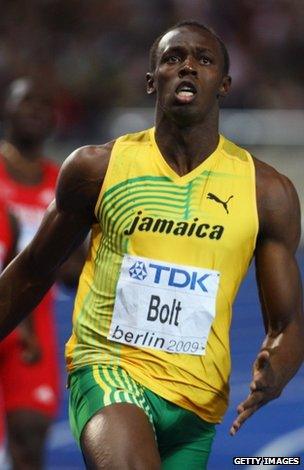Cheetah tracking study reveals incredible acceleration
- Published
See cheetahs, filmed for the research project Ann van Dyk Cheetah Centre in South Africa, making a series of quick turns, starts and stops
The fastest animal on land rarely uses its top speed to capture prey, according to a new analysis.
A study of cheetahs has shown that instead, the animal uses incredible acceleration and rapid changes in speed when hunting.
The animals get this acceleration by exerting nearly five times more power than that of famed sprinter Usain Bolt during his record-breaking 100m run.
The results are published in the journal Nature, external.
The findings amazed the scientist who led the research, Prof Alan Wilson of the Royal Veterinary College in Hatfield, UK.
"They are remarkable athletes - not just in terms of their speed, but also with their ability to accelerate and manoeuvre in capturing the prey," he told BBC News.
The top speed for a cheetah is often quoted is 65mph (105km/h) - a result measured in 1965 and published in the Journal of Zoology, external three decades later by a scientist in Kenya. He was timing the run of a semi-domesticated cheetah running in a straight line on a firm dirt track.
But a well-fed zoo cheetah is not accustomed to running very fast - it does not need to. As a result, few measurements of zoo cheetahs found speeds greater than that of a greyhound, about 40mph (64km/h).
So for years, researchers wondered whether cheetahs might run much faster than 65mph in the wild in order to capture prey.
Rapid acceleration
Prof Wilson and his team at the college's Structure and Motion Laboratory decided to find out by following five animals in the wild for a year using tracking collars fitted with movement detectors and GPS systems.
They found that the cheetahs did indeed run very fast at times - close to 60mph - but only occasionally. On most hunts they attained about 30 to 35 mph but they were accelerating and changing direction much more rapidly than has been seen in any other land animal.

For sprinters and predators, speed is not the only variable for success - acceleration counts
They found that cheetahs could increase their speed by nearly 7mph (10km/h) in a single stride.
"They've arranged to have a low gear so they can accelerate very rapidly up to their top speed," said Prof Wilson.
Short bursts of speed can be quantified in power per kilogramme of the animal's weight. Jamaican sprinter Usain Bolt exerted 25 W/kg during his record-breaking run in 2009.
A horse used in a polo match exerts slightly more power per kg, around 30 W/kg, and a greyhound's is double that at 60 W/kg. But a cheetah can reach 120 W/kg.
The researchers also found that cheetahs also have a very strong grip, so much so that they rip up the ground as they run. They found it was the use of the animals' claws that enabled them to turn very sharply and to accelerate and decelerate very quickly.
The measurements have only been made possible because of the collars that have been developed by Prof Wilson specifically for the experiment.
"It is very hard for GPS to work on an animal that is ducking and diving, so the collar is an innovation in its own right," he said.
"We've been working on GPS for 12 years and the collars are the result of those labours. They are not your typical GPS tracking system that you get in the car or phone.
"The GPS is far more accurate we are getting positions and speeds five times a second. We combine those with readings from other instruments and we finish up with something that is very much more accurate both in terms of speed and position and very much more robust," Prof Wilson explained.
The team are currently using the collars to track lions and African wild dogs to obtain comparative measurements.
Follow Pallab on Twitter, external
- Published6 September 2012